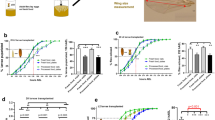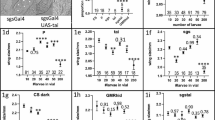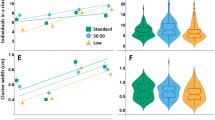Abstract
Cooperative behavior often arises when a common exploitable resource is generated. Cooperation can provide equitable distribution and protection from raiding of a common resource such as processed food. Under crowded conditions in liquid food, Drosophila larvae adopt synchronized feeding behavior which provides a fitness benefit. A key for this synchronized feeding behavior is the visually guided alignment of a 1–2 s locomotion stride between adjacent larvae in a feeding cluster. The locomotion stride is thought to be set by embryonic incubation temperature. This raises a question as to whether sib larvae will only cluster efficiently if they hatch at the same temperature. To test this, larvae were first collected and incubated in outdoor conditions. Morning hatched lower temperature larvae move slower than their afternoon higher temperature sibs. Both temperature types synchronize but tend to exclude the other type of larvae from their clusters. In addition, fitness, as measured by adult wing size, is highest when larvae cluster with their own temperature type. Thus, the temperature at which an egg is laid sets a type of behavioral stamp or password which locks in membership for later cooperative feeding.


Similar content being viewed by others
References
Allee WC (1927) Studies in animal aggregations: some physiological effects of aggregation on the brittle starfish, Ophioderma brevispina. J Exp Zool 48:475–495. https://doi.org/10.1002/jez.1400480208
Behrman EL, Watson SS, O’Brien KR, Heschel MS, Schmidt PS (2015) Seasonal variation in life history traits in two Drosophila species. J Evol Biol 28:1691–1704. https://doi.org/10.1111/jeb.12690
Beyramysoltan S, Ventura MI, Rosati Y, Giffen-Lemieux JE, Musah R A (2020) Identification of the species constituents of Maggot populations feeding on decomposing remains—facilitation of the determination of post mortem interval and time since tissue infestation through application of machine learning and direct analysis in real time-mass spectrometry. Anal Chem 92:5439–5446. https://doi.org/10.1021/acs.analchem.0c00199
Carton Y, David JR (1985) Relation between the genetic variability of digging behavior of Drosophila larvae and their susceptibility to a parasitic wasp. Behav Genet 15:143–154. https://doi.org/10.1007/BF01065895
Dombrovski M, Poussard L, Moalem K, Kmecova L, Hogan N, Schott E, Vaccari A, Acton S, Condron B (2017) Cooperative behavior emerges among Drosophila larvae. Curr Biol 27:2821–2826.e2. https://doi.org/10.1016/j.cub.2017.07.054
Dombrovski M, Kim A, Poussard L, Vaccari A, Acton S, Spillman E, Condron B, Yuan Q (2019) A plastic visual pathway regulates cooperative behavior in Drosophila larvae. Curr Biol 29:1866–1876.e5. https://doi.org/10.1016/j.cub.2019.04.060
Dombrovski M, Kuhar R, Mitchell A, Shelton H, Condron B (2020) Cooperative foraging during larval stage affects fitness in Drosophila. J Comp Physiol A 206:743–755. https://doi.org/10.1007/s00359-020-01434-6
Fisher AM, Page S, Le Manser A, Lewis D, Holwell G, Wigby S, Price T (2021) Relatedness modulates density-dependent cannibalism rates in Drosophila. Funct Ecol. https://doi.org/10.1111/1365-2435.13913
Foster KR, Wenseleers T, Ratnieks FLW (2006) Kin selection is the key to altruism. Trends Ecol Evol 21:57–60. https://doi.org/10.1016/j.tree.2005.11.020
Giachello C, Fan YN, Landgraf M, Baines R (2019) Activity manipulation of an excitatory interneuron, during an embryonic critical period, alters network tuning of the Drosophila larval locomotor circuit. bioRxiv. https://doi.org/10.1101/780221
Gilchrist AS, Partridge L (1999) A comparison of the genetic basis of wing size divergence in three parallel body size clines of Drosophila melanogaster. Genetics 153:1775–1787. https://doi.org/10.1093/GENETICS/153.4.1775
Gregg TG, McCrate A, Reveal G, Hall S, Rypstra AL (1990) Insectivory and social digestion in Drosophila. Biochem Genet 28:197–207. https://doi.org/10.1007/bf00561337
Keene AC, Mazzoni EO, Zhen J, Younger MA, Yamaguchi S, Blau J, Desplan C, Sprecher S (2011) Distinct visual pathways mediate Drosophila larval light avoidance and circadian clock entrainment. J Neurosci 31:6527. https://doi.org/10.1523/JNEUROSCI.6165-10.2011
Khodaei L, Long TAF (2019) Kin recognition and co-operative foraging in Drosophila melanogaster larvae. J Evol Biol 32:1352–1361. https://doi.org/10.1111/jeb.13531
Kohsaka H, Takasu E, Morimoto T, Nose A (2014) A group of segmental premotor interneurons regulates the speed of axial locomotion in Drosophila larvae. Curr Biol 24:2632–2642. https://doi.org/10.1016/j.cub.2014.09.026
Lindstedt C, Miettinen A, Freitak D, Ketola T, López-Sepulcre A, Mäntylä E, Pakkanen H (2018) Ecological conditions alter cooperative behavior and its costs in a chemically defended sawfly. Proc R Soc B 285:1884. https://doi.org/10.1098/rspb.2018.0466
Moore JA (1952) Competition between Drosophila melanogaster and Drosophila simulans. Proc Natl Acad Sci 38:813–817. https://doi.org/10.1073/PNAS.38.9.813
Nowak MA (2006) Five rules for the evolution of cooperation. Science 80:314:1560–1563. https://doi.org/10.1126/science.113375
Oswald MCW, Brooks PS, Zwart MF, Mukherjee A, West RJH, Giachello CNG, Morarach K, Baines RA, Sweeney ST, Landgraf M (2018) Reactive oxygen species regulate activity dependent neuronal plasticity in Drosophila. Elife 7:e39393. https://doi.org/10.7554/eLife.39393
Raihani NJ, Thornton A, Bshary R (2012) Punishment and cooperation in nature. Trends Ecol Evol 27:288–295. DOI:https://doi.org/10.1016/j.tree.2011.12.004
Scanvion Q, Hédouin V, Charabidzé D (2018) Collective exodigestion favours blow fly colonization and development on fresh carcasses. Anim Behav 141:221–232. https://doi.org/10.1016/j.anbehav.2018.05.012
Szuperak M, Churgin MA, Borja AJ, Raizen DM, Fang-Yen C, Kayser MS (2018) A sleep state in Drosophila larvae required for neural stem cell proliferation. Elife. https://doi.org/10.7554/ELIFE.33220
Vickery WL, Giraldeau LA, Templeton JJ, Kramer DL, Chapman CA (1991) Producers, scroungers, and group foraging. Am Nat 137:847–863. https://doi.org/10.1086/285197
Acknowledgements
We thank the Bloomington Stock Center for providing fly stocks. We thank Drs A Bergland, F. Nelson and members of the Condron lab for providing advice and comments. This work was supported by the Owen’s Family Foundation (BC).
Author information
Authors and Affiliations
Contributions
Conceptualization and methodology: BC and MW; data collection: AM, MW and BC; data analysis: MW and BC; writing, reviewing and editing: MW and BC; funding acquisition: BC.
Corresponding author
Ethics declarations
Conflict of interest
All authors declare no conflict of interest. The authors declare no competing financial interests.
Additional information
Publisher’s Note
Springer Nature remains neutral with regard to jurisdictional claims in published maps and institutional affiliations.
Rights and permissions
About this article
Cite this article
Williamson, M., Mitchell, A. & Condron, B. Birth temperature followed by a visual critical period determines cooperative group membership. J Comp Physiol A 207, 739–746 (2021). https://doi.org/10.1007/s00359-021-01512-3
Received:
Revised:
Accepted:
Published:
Issue Date:
DOI: https://doi.org/10.1007/s00359-021-01512-3




